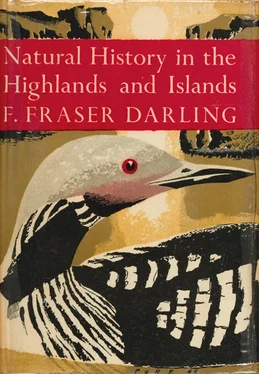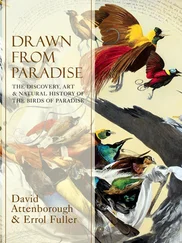Tradition has it that the climate of the Highlands and Islands has deteriorated in living memory and in the fifty to seventy years before that. The meteorologists are always telling us we are wrong in thinking the weather was better in “our young days.” All the same, in the North-West Highlands salt pans were in general use many years ago for evaporating sea water, but it is said the fall in the amount of sunshine—much more than the remission of the salt tax—was responsible for their use being discontinued.
It will be best for us to consider the climatic factor of snow when we come to note its effect in the higher mountainous regions. But let it be said that the Highlands as a whole do not suffer nearly so much snow as the Southern Uplands of Scotland or the Pennine Chain of England. Snow comes earlier and stays later on the tops of the hills because the factor of altitude is concerned, but the Atlantic mildness pervades much of the lower ground. Nearness to the sea is a considerable factor in determining how low the snow will come on a hill face and how long it will stay. This is brought home to anyone living offshore from the West Highland mainland and who has for a view a wide range of peaks stretching from three to twenty miles inland. Snow as a climatic factor can be of much importance in a region long after it has fallen if the catchment area of the snow is large. The Cairngorm hills provide an excellent example: their greatest accumulation of snow is at the end of April or even in early May, whereafter there is a steady melting which is not complete until August. It is in the dry month of June that the snow held on the spacious tops and plateaux of this region can maintain the water even in rapid-running rivers and affect the fish life down in the Spey and Dee Valleys. Obviously, snow has a great effect on plant and animal life in areas where it lies long, but we are here dealing with the general climate of the Highlands and must not be drawn away into discussion of local and micro-climates.
The shore line of the West Highland mainland is particularly free from snow. I have known years when the snow has not lain for more than a couple of hours in a whole winter—and then, like as not, it has been at the end of April or in the first week of May. That first week or so of May is regularly a wintry period, and is so well known in the North that it is called the Gab o’ May. Taken all in all, it is remarkable how little is the effect of snow on vegetation in the Highlands except on the summits and in those places where it drifts and packs. Its influence on the behaviour of animals may be profound, but of that more later.
Frost has a distribution in the Highlands somewhat like that of snow, except for the peculiar conditions which will produce spring or autumn frosts on the floor of a glen and not at a few hundred feet up the hillsides. That is a phenomenon, of course, which is known all too well in the fruit-growing districts of England. The shore line of islands off the western seaboard may, as has been said, register no more than 2° F. of frost all winter, but occasional bad years such as the early 1940’s may show up to 14° F. of frost. I remember seeing very thin pancake ice forming on the flat-calm sea of the Anchorage of Tanera in January 1941. Tanera is well out to the Minch and the sea is of fairly high salinity there.
Wind is a climatic factor of great variability and of exceedingly great importance in Highland natural history and the topography of the area. It would be entirely wrong to call the Highlands windswept; it cannot even be said truly that the coastal areas are windswept, for here on the shores of Loch Sunart where I am writing, the trees round the house are of beautiful symmetry and of great height, yet only 150 yards away on a shingle beach the wind blows much harder. The summits of the hills are windswept and the outer coasts are still more windswept, and it should be understood that the outer coasts of the North-West Highlands are the windiest part of Great Britain; much windier, for example, than the Shetland Isles or the outer Norwegian coast, or Valencia Island off south-west Ireland. The gales above 4,000 feet are worse than on the coast; the meteorological data from the Ben Nevis Observatory period gave an average of 261 gales a year of more than 50 m.p.h.
On the outer coasts of the Highlands gusts of 100 m.p.h. occur from time to time, and in certain places, where the configuration of the hills governs the play of wind, there are freak gusts and up and down draughts of excessive strength. In December 1938, I was going over the hill of North Rona during a three-day southerly gale to fetch water from the well on the southern cliff face. The wind was not so bad as it had been in the night, but I had to go on hands and knees over the ridge at 300 feet, from which there was an unbroken downward sweep to the sea on the south. When I reached the edge of the 70-foot cliffs which were at an angle of 30° from the vertical, I saw the turf at the edge of the cliff being lifted like the edge of a blanket, and the outer fringes of it were being torn off and flung inland just as a blanket would wear in a wind. All this is common enough in the islands; I had seen it before. But a few yards inland I saw two bare patches in the turf where two boulders had rested for years; the black surface of the bare patch was a good inch below the turf, and the boulders themselves—a foot to eighteen inches across and about eight inches high—were rolled uphill a distance of about three feet. The seals might well have shifted them had they been there, but no seals wandered in that part of the island. Only the force of the wind could have moved those stones, and as I still cannot believe that any wind we know could turn up the dead weight of a boulder well set with a flat bottom in the turf, presumably the cliff being set at that angle had the effect of multiplying the force of the wind at the upper edge; and a fairly large area of turf must have been lifted and stretched in some of the gusts, with the result that the boulders would be thrown out of their sockets uphill. The effect of wind is much less farther inland from the sea. The tree line on the coasts may be no more than 200 feet—assuming that trees will grow at all—whereas it is 1,800 feet on the western side of the Cairngorms. The prevailing wind in the Highlands is from the south-west. Such winds come off the relatively warm waters of the North Atlantic Drift and are laden with moisture. The weather is rarely cold during the time they blow. If the observer is far enough out from the high hills to see what is really happening in the sky, he will note that the south-westerly gales are predictable from the movements of the clouds before the wind is felt at sea level, or he may see a great bank of cloud out to the west in the Atlantic the night before. The south-westerly gales are gusty even out on the coasts, but they are so moisture-laden that one’s sense of smell is heightened: earth and sea have a beauty of their own at such a time through the scents they convey. The observer is watching the sky for signs of the end of the gale and sees a break of blue sky for a moment; then he notices that the clouds are no longer moving from the south-west but from the west. Soon he feels the wind to be coming from the west at sea level and the clouds are moving from north-west. Finally the wind veers farther to north-west and falls light in the north. That is the end of the gale.
The trough of low barometric pressure is left behind and the recording needle marks a steady rise and then levels off as the wind reaches the north. These gales have a closely similar pattern: in winter they may last several days; or only twenty hours in summer, sometimes completing the pattern day after day, beginning in the early morning with short gusts which are the forerunners and falling light in the late evening. It is the West Highland coast which shows up these gales as if under a magnifying glass. They will be mere breezes a few miles inland or at the head of a sea loch. Only their raininess will be felt there. The barograph shows less pronounced movement also, back in from the coast.
Читать дальше












